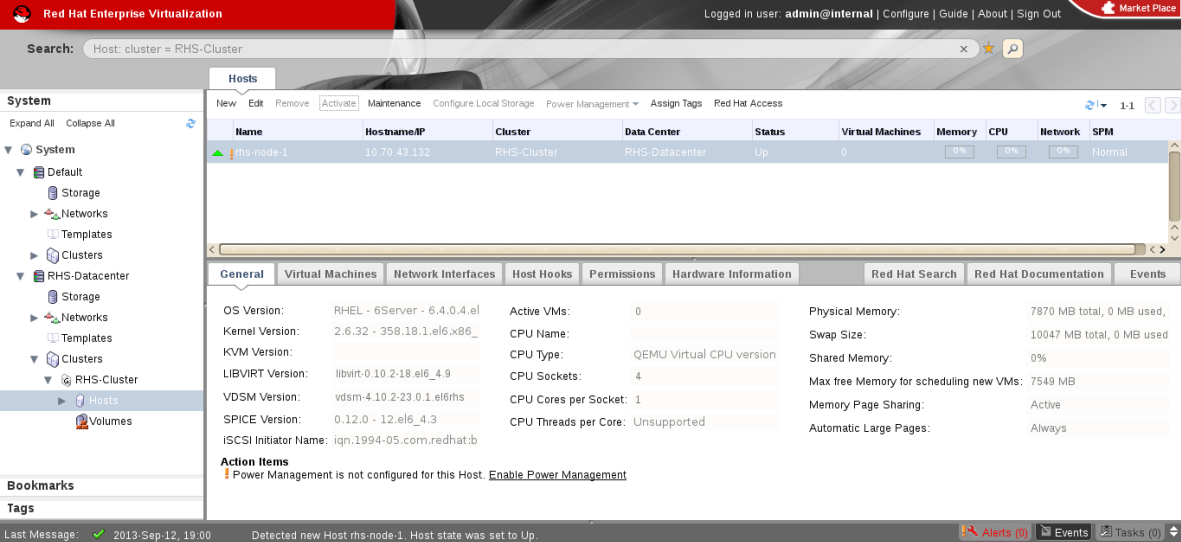이 콘텐츠는 선택한 언어로 제공되지 않습니다.
Chapter 9. Upgrading from Red Hat Gluster Storage 3.2 to Red Hat Gluster Storage 3.3 in a Red Hat Enterprise Virtualization-Red Hat Gluster Storage Environment
This section describes the upgrade methods for a Red Hat Gluster Storage and Red Hat Enterprise Virtualization integrated environment. You can upgrade Red Hat Gluster Storage 3.2 to Red Hat Gluster Storage 3.3 using an ISO or
yum.
Warning
Before you upgrade, be aware of changed requirements that exist after Red Hat Gluster Storage 3.1.3. If you want to access a volume being provided by a Red Hat Gluster Storage 3.1.3 or higher server, your client must also be using Red Hat Gluster Storage 3.1.3 or higher. Accessing volumes from other client versions can result in data becoming unavailable and problems with directory operations. This requirement exists because Red Hat Gluster Storage 3.1.3 contained a number of changes that affect how the Distributed Hash Table works in order to improve directory consistency and remove the effects seen in BZ#1115367 and BZ#1118762.
Important
In Red Hat Enterprise Linux 7 based Red Hat Gluster Storage, updating to 3.1 or higher reloads firewall rules. All runtime-only changes made before the reload are lost.
9.1. Upgrading using an ISO
링크 복사링크가 클립보드에 복사되었습니다!
- Using Red Hat Enterprise Virtualization Manager, stop all the virtual machine instances.The Red Hat Gluster Storage volume on the instances will be stopped during the upgrade.
- Using Red Hat Enterprise Virtualization Manager, move the data domain of the data center to Maintenance mode.
- Using Red Hat Enterprise Virtualization Manager, stop the volume (the volume used for data domain) containing Red Hat Gluster Storage nodes in the data center.
- Using Red Hat Enterprise Virtualization Manager, move all Red Hat Gluster Storage nodes to Maintenance mode.
- Perform the ISO Upgrade as mentioned in section Section 8.2.1.3, “Configuring repo for Upgrading using ISO”.
- Re-install the Red Hat Gluster Storage nodes from Red Hat Enterprise Virtualization Manager.
Note
- Re-installation for the Red Hat Gluster Storage nodes should be done from Red Hat Enterprise Virtualization Manager. The newly upgraded Red Hat Gluster Storage 3.3 nodes lose their network configuration and other configuration details, such as firewall configuration, which was done while adding the nodes to Red Hat Enterprise Virtualization Manager. Re-install the Red Hat Gluster Storage nodes to have the bootstrapping done.
- You can re-configure the Red Hat Gluster Storage nodes using the option provided under Action Items, as shown in Figure 9.1, “Red Hat Gluster Storage Node before Upgrade ”, and perform bootstrapping.
Figure 9.1. Red Hat Gluster Storage Node before Upgrade
- Perform the steps above in all Red Hat Gluster Storage nodes.
- Start the volume once all the nodes are shown in Up status in Red Hat Enterprise Virtualization Manager.
- Upgrade the native client bits for Red Hat Enterprise Linux 6 or Red Hat Enterprise Linux 7, depending on the hypervisor you are using.
Note
If Red Hat Enterprise Virtualization Hypervisor is used as hypervisor, then install a suitable build of Red Hat Enterprise Virtualization Hypervisor containing the latest native client.Figure 9.2. Red Hat Gluster Storage Node after Upgrade
- Using Red Hat Enterprise Virtualization Manager, activate the data domain and start all the virtual machine instances in the data center.

